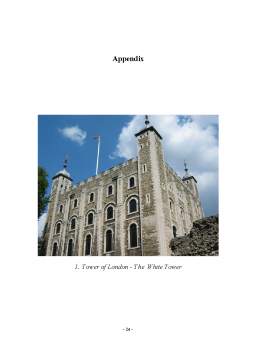Cuprins
- 1.Introduction page 2
- 2.The Development of the Tower page 3
- 3.The late 17th century and the 18th century page 5
- 4.The Tower in the 19th century page 6
- 5.Restoring the Tower page 7
- 6.The Tower in the 20th century page 9
- 7.The Towers of the Tower of London page 10
- 8.The institutions of the Tower page 13
- 9. Torture at the Tower of London page16
- 10. Conclusion page23
- 11.Appendix page24
- 12. Bibliography page28
Extras din proiect
Introduction
The Tower of London is by far one of the most famous and well preserved historical buildings in the world. From its earliest structural beginnings by its founder William I of England better known as William the Conqueror 1066-87, the Great Tower or White Tower as it later came to be called was fast becoming the most talked-about building -'in England. The White Tower was also the most awe inspiring, and frightening structure to the Anglo-Saxon people who were trying to get used to the rule of their new Norman king, the destroyer of their own ruler, Harold II, at the in 1066. Within three months of his victory William the Conueror had begun to build a castle on the north bank of the river Thames in London.
Beginning life as a simple timber and earth enclosure tucked in the south-east angle formed by the joining of the original east and south stone walls of the old Roman town of Londinium Augusta, the original structure was completed by the addition of a ditch and palisade along the north and west sides
This enclosure then received a huge structure of stone which in time came to be called The Great Tower and eventually as it is known today The White Tower. This formed the basis of a residential palace and fortress ideally suited for a king or queen and as history has shown, to its regal occupants the Tower of London became the perfect all purpose complex. Since the first foundations were laid more than 900 years ago the castle has been constantly improved and extended by the addition of other smaller towers, extra buildings, walls and walkways, gradually evolving into the splendid example of castle, fortress, prison, palace and finally museum that it proudly represents today.
The development of the Tower
The Tower of London was begun in the reign of William the Conqueror (1066-87) and remained unchanged for over a century. Then, between 1190 and 1285, the White Tower was encircled by two towered curtain walls and a great moat. The only important enlargement of the Tower after that time was the building of the wharf, begun by Edward III (1327-77) and completed under Richard II (1377-99). Today the medieval defences remain relatively unchanged, except at the western entrance.
Castle building was an essential part of the Norman Conquest: when Duke William of Normandy invaded England in 1066 his first action after landing at pevensey on 28 September had been to improvise a castle, and when he moved to Hastings two days later he built another. Over the next few years William and his supporters were engaged in building hundreds more, first to conquer, then subdue and finally to colonise the whole of England. By the end of the Anglo-Saxon period London had become the most powerful city in England, with a rich port, a nearby royal palace and an important cathedral. Securing the City was, therefore, of the utmost importance to William and within days of his coronation he had ordered fortifications to be built to control its 'vast and fierce populace'. These fortifications almost certainly included the future Tower of London. Initially the Tower had consisted of a modest enclosure built into the south-east corner of the Roman city walls, but by the late 1070s, with the initial completion of the White Tower, it had become the most fearsome of all. Nothing had been seen like it in England before. It was built by Norman masons and English (Anglo-Saxon) labour drafted in from the countryside, perhaps to the design of Gundulf, Bishop of Rochester. It was intended to protect the river route from Danish attack, but also and more importantly to dominate the City physically and visually. The White Tower was protected to the east and south by the old Roman city walls, while the north and west sides were protected by ditches as much as 7.50m (25ft) wide and 3.40m (11ft) deep and an earthwork with a wooden wall on top. In the 12th century a 'fore-building' (now demolished) was added to the south front of the White Tower to protect the entrance. The Wardrobe Tower, a fragment of which can be seen at the south-east corner of the building, was another early addition or rebuilding. From very early on the enclosure contained a number of timber buildings for residential and service use. It is not clear whether these included a royal residence but William the Conqueror's immediate successors probably made use of the White Tower itself.
Preview document
Conținut arhivă zip
- Tower of London.doc











































